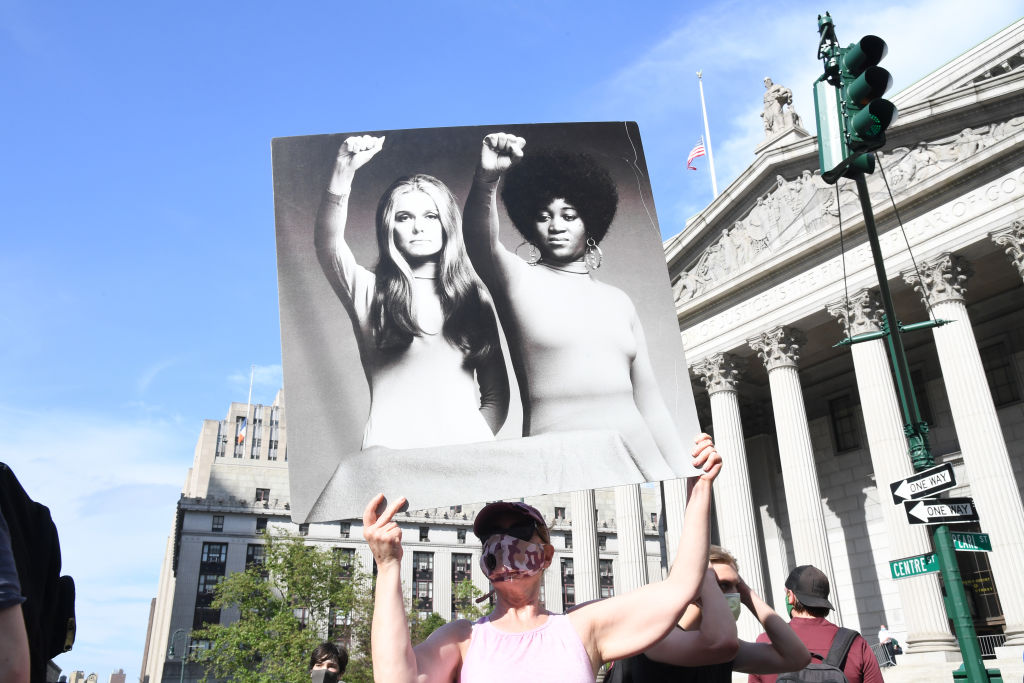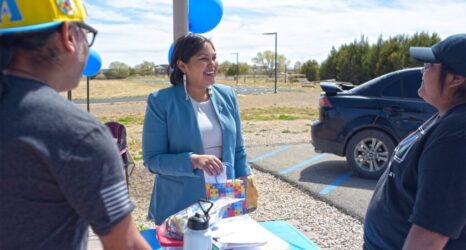Dorothy Pitman Hughes worked with other feminists to center Black women’s experiences in the women’s movement.

Pioneering feminist Dorothy Pitman Hughes died on Dec. 1, 2022, at the age of 84. Hughes became an icon of the women’s movement when Esquire published an image of her and Gloria Steinem in 1971 standing side by side with fists raised. That image has since been recreated, reinterpreted and reproduced on everything from mugs to T-shirts. A copy even hangs in the Smithsonian’s National Museum of African American History and Culture.
Dorothy Pitman Hughes’ life of activism, however, transcended this image.
When Steinem sought her out, Hughes was renowned as a community activist who created a childcare center that served as a hub for political action in the 1960s and ’70s. She went on to speak out and organize about civil rights, feminism, racist beauty standards and destructive patterns of gentrification in New York City.
When she moved to New York from rural Georgia in the late 1950s, Hughes said she became involved in everything she could that “represented civil rights, human rights and equality.” From her first efforts raising funds for the Congress of Racial Equality (CORE) in the early 1960s, she turned her attention to the conditions in her West Side neighborhood.
Because she worked nights as a nightclub singer, Hughes witnessed children in her neighborhood while she was at home during the day “doing the cooking, cleaning and clothes washing,” and even “taking care of babies,” as their parents worked. Hughes started a community daycare for these children.
At the same time, she had the revelation that this was not simply a childcare issue. Hughes realized that entangled with the children of the West Side were issues of racial discrimination, poverty, drug use, sub-standard housing, welfare hotels, lack of job training and even the Vietnam War. This was why the childcare center that she imagined and created was essential: It became a center for the community to define its needs, fashion its own solutions, and take to the streets in protest when it was called for.
Hughes’ activism was astonishingly multifaceted. Through the childcare center, she created community-controlled resources that focused on daycare but also on-the-job training, adult education classes, a Youth Action Corps, housing assistance, protection from domestic violence and food resources on the West Side of Manhattan before gentrification.
The childcare center she imagined and created became a center for the community to define its needs, fashion its own solutions, and take to the streets in protest when it was called for.
When Steinem first met Hughes, Steinem was a reporter and Hughes was the better-known activist. As Steinem began reporting on Hughes’ community and childcare center on the West Side, they both became more involved in the emerging women’s movement. As a singer and activist comfortable in front of a crowd and willing to lead occupation protests of city offices, Hughes persuaded Steinem to speak publicly. They travelled together, speaking on the women’s movement, childcare and welfare in the early 1970s.
Hughes’ style as a speaker was to directly call out the racism she saw in the white women’s movement. She frequently took to the stage to articulate the way in which white women’s privilege oppressed Black women, yet she offered the example of her explicit friendship with Steinem as proof that this obstacle could be overcome.
In more general terms, their relationship speaks to tensions in the early women’s movement regarding race and the ease with which Black women’s experience and activism could be pushed to the margins. She and Steinem worked together to center Black women’s experiences in the women’s movement, although they were not as successful as either would have wanted.
Hughes transitioned away from the West 80th Street Childcare Center in the ’80s when she moved to Harlem and became a business owner and community activist in a different way.
In the mid-1980s, Hughes bought the franchise for the Miss Greater New York City Pageant. She had three daughters: Delethia, Patrice and Angela. The pageant process disturbed her, because of the message she saw it conveying to her children. For Hughes, the pageant celebrated white beauty standards, so she deliberately sought to diversify the pageant and showcase the beauty of women of color in New York City. Her stint as a pageant owner was short-lived, but diversity was soon recognized when Vanessa Williams won the Miss America title two years after Hughes’ efforts.
In the mid-1980s, Hughes bought the franchise for the Miss Greater New York City Pageant. … Her stint as a pageant owner was short-lived, but diversity was soon recognized when Vanessa Williams won the Miss America title two years after Hughes’ efforts.
At the same time, Hughes was operating Harlem Office Supply, a community center of a different sort that allowed her to organize around economic empowerment, especially for Black women in Harlem. Dorothy had moved to Harlem in part to counter accelerating gentrification. Because she was used to dealing with government programs, Hughes saw President Clinton’s 1994 creation of the Upper Manhattan Empowerment Zone as a tremendous opportunity for herself and other African American businesspeople in Harlem.
She organized Harlem women to own and run their businesses with the hope of government support—only to be disappointed when those opportunities went to national chains, not local owners. For Hughes, the gentrification of Harlem became a form of “ethnic cleansing” as Black business owners were moved out under the guise of “economic empowerment.” Her own Harlem Office Supply was replaced by a Staples.
Hughes left New York City for Florida in 2003. Where others might have retired, she continued to respond to the needs of her community.
In Jacksonville, she recognized that the traditionally Black neighborhood was a food desert. Inspired by Michele Obama’s garden at the White House, Hughes realized that community gardens in North Jacksonville could have a powerful and transformative effect in Jacksonville and organized a community garden project.
Dorothy Pitman Hughes was perceptive, outspoken and engaged. Her life is a testament to her commitment to community empowerment and the transformative power of feminist activism.
Rest in power, Dorothy.
Up next:
U.S. democracy is at a dangerous inflection point—from the demise of abortion rights, to a lack of pay equity and parental leave, to skyrocketing maternal mortality, and attacks on trans health. Left unchecked, these crises will lead to wider gaps in political participation and representation. For 50 years, Ms. has been forging feminist journalism—reporting, rebelling and truth-telling from the front-lines, championing the Equal Rights Amendment, and centering the stories of those most impacted. With all that’s at stake for equality, we are redoubling our commitment for the next 50 years. In turn, we need your help, Support Ms. today with a donation—any amount that is meaningful to you. For as little as $5 each month, you’ll receive the print magazine along with our e-newsletters, action alerts, and invitations to Ms. Studios events and podcasts. We are grateful for your loyalty and ferocity.





